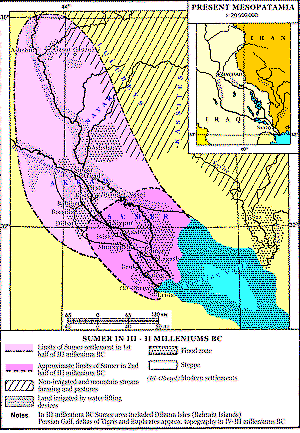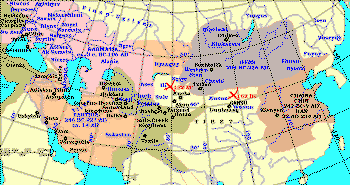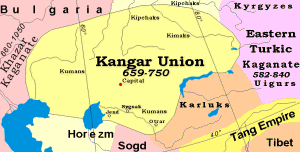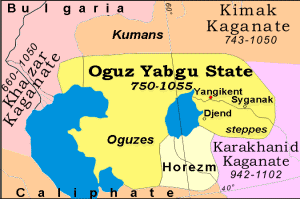Introduction
The name of the tribe Kangly may be also spelled Kanly, Kankalis or Qanqlis, they are Kangars, Kengeress, and Kangju of annals and inscriptions.
Periodization:
| Afanasiev | 2,500 -1,500 BC | Kurgan Culture, settled or semi-settled, cattle breeding, domesticated sheep, bull and horse, subsistence hunting and fishing |
| Andronov | 1,500 - 1,000 BC | Kurgan Culture, settled and semi-nomadic cattle breeding, domesticated sheep, bull and horse |
| Karasük | 1,000 BC - 500 BC | Kurgan Culture, semi-nomadic, cattle breeding, |
| Tashtyk | 200 BC - 200 AD | Kurgan Culture, nomadic cattle breeding and settled agriculture |
|
Kaunchi |
200 BC - 700 AD | Kurgan Culture, nomadic cattle breeding and settled agriculture - Kangars |
| Jetyasar | 200 BC - 700 AD | Kurgan Culture, nomadic cattle breeding and settled agriculture - Kangars |
Kangars are known in Mesopotamia from Sumerian times, the endonym of Sumers was Kang, at least the endonym of a certain part of Sumers. The Turkic etymology of the Kang is "ancestor", which may very well explain the Central Asian Kangars, but who was the ancestor of the Sumerian Kangs, and how did they get that appellative? In Chinese annals the first references to Kangars in the form Kangju are associated with the name for Fergana 大宛 Dawan/Davan/Daiuan/Dayuan/Da-yuan/Ta-Yüan/Ta-Yuan, "Great Yuan", literally "Great Ionians", which explains the rectangular layout of the Kaunchi settlements: the archeology so far was digging up the Greek colonies in the Kangar lands, finding Greek and probably mixed and indigenous burials, but missing the much less visible indigenous settlement and accompanying burials. About Kangar/Badjanak graves we know from S.A.Pletneva: Badjanaks buried the horse or its effigy next to the diseased in a wide grave suitable to contain a human and a horse corpses, in a shallower grave.
By the time Kangars reached Europe at about 890 AD, they maybe numbered 500,000 people, 1,200,000 wagons, 30,000,000 cattle, 100,000 cavalry army. A good portion of them remained in situ, joining the ruling powers of the time, or melted away in different directions, leaving their traces on the way.Kaunchi_culture
http://en.wikipedia.org/wiki/Dzhetyasar_culture
17 May 2011
The most significant forts are Altynasar (17 hectares), Kuraylyasar, Karaasar, Bazarasar, Tompakasar, Zhalpakasar. The tells rise above the surrounding plain from two to ten meters.
All settlements of the Jetyasar culture are well fortified, located at the ancient riverbed, they have one or more two-three story fortresses, apparently community buildings. The population economy was animal husbandry, irrigated farming, and fisheries. Archaeologists associate the Jetyasar culture with the culture of the ancient Tokhars and Hephthalites, or with the culture of Kangar tribes.
|
Tokhars - presumably "highlanders", from "tau" - mountain and "ar" - people, tribe; their known Türkic names are Tuhsi, Dügers, Digors; they became known from the work of Strabo, after the conquest of Bactria, coupled with the tribes of Aces - their dynastic tribe - and Subars, the Suvars of the Bulgar confederation and Severyans of the Slavs. Hephthalites - Türkic tribe Abdaly, known from the Zacharias Rhetorician list of 13 nomadic tribes. Both names, Tokhars and Hephthalites, are exploited by protagonists of Indo-European racial theory as a bridge for creation alternative history and introduction of Indo-Europeans in the history of Central Asia, and creation of scientific controversy and muddling up the history. Both tribes are known as members of the Eastern Hunnic state; the Chinese name Yuezhi is routinely used in the scientific and popular literature to refer to Tokhars. Kangar - Türkic tribe known from the Chinese annals of the Eastern Huns times, the ancestors of the modern Kazakh tribe Kangly and its branches in the other states. |
The monuments were first excavated in 1946-51 by the USSR Khorezm Archaeological and Ethnographic Expedition under a leadership of S.P. Tolstov. In 1973-1993 excavations continued under a leadership of L.M. Levina. The most significant protective excavations of the Altynasar settlement and surrounding necropolices were done in the second half of 1980's - early 1990's because of water pipeline construction to bring artesian water from Kyzylkum desert to Baikonur.
Literature
Tolstov S.P., The ancient deltas of Oxsus and Jaxartes, Moscow, 1962 (In Russian)
Tolstov S.P., Following ancient Horesm civilization, Part 2. Ch. 6
http://www.opentextnn.ru/history/archaeology/expedetion/Tolstov/?id=1635 (In Russian)
Levina L.M., Jetyasar culture, Parts 3-4. Altynasar necropolices 4 / Lower Syrdarya in
antiquity, Vol. 4, Moscow, IEA RAN, 1994, ISBN 5-201-00815-1
http://www.iea.ras.ru/books/nizovyasirdari1994.zip (In Russian)
Levina L.M., Ethno-cultural history of Eastern Aral Sea region. 1st millennium BCE - 1
millennium CE // Moscow, 1996, ISBN 5-02-017901-9
http://kronk.narod.ru/library/levina-lm-1996.htm (Table of contents, Introduction,
In Russian)
Akishev K.A., Baipakov K.M., Problems of Kazakhstan archaeology, Alma-Ata, 1979 (In
Russian)
L-1941-XXVIII - 1: 200 000 topographic map of Jetyasar area
http://mapl41.narod.ru/map2/index28.html
Archaeological cultures
History of the Turkic people
History of the Turkish people
National histories
Archaeology of Kazakhstan
Archaeology of Uzbekistan
http://en.wikipedia.org/wiki/Sintashta-Petrovka
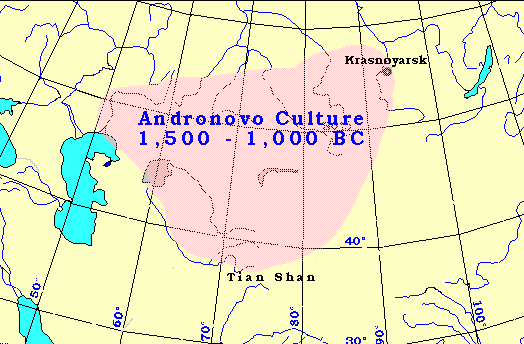 |
Map of the approximate maximal extent of the Andronovo culture. The formative Sintashta-Petrovka culture is shown in darker red. The location of the earliest spoke-wheeled chariot finds is indicated in purple. Adjacent and overlapping cultures (Afanasevo culture, Timber Grave culture, BMAC) are shown in green. |
